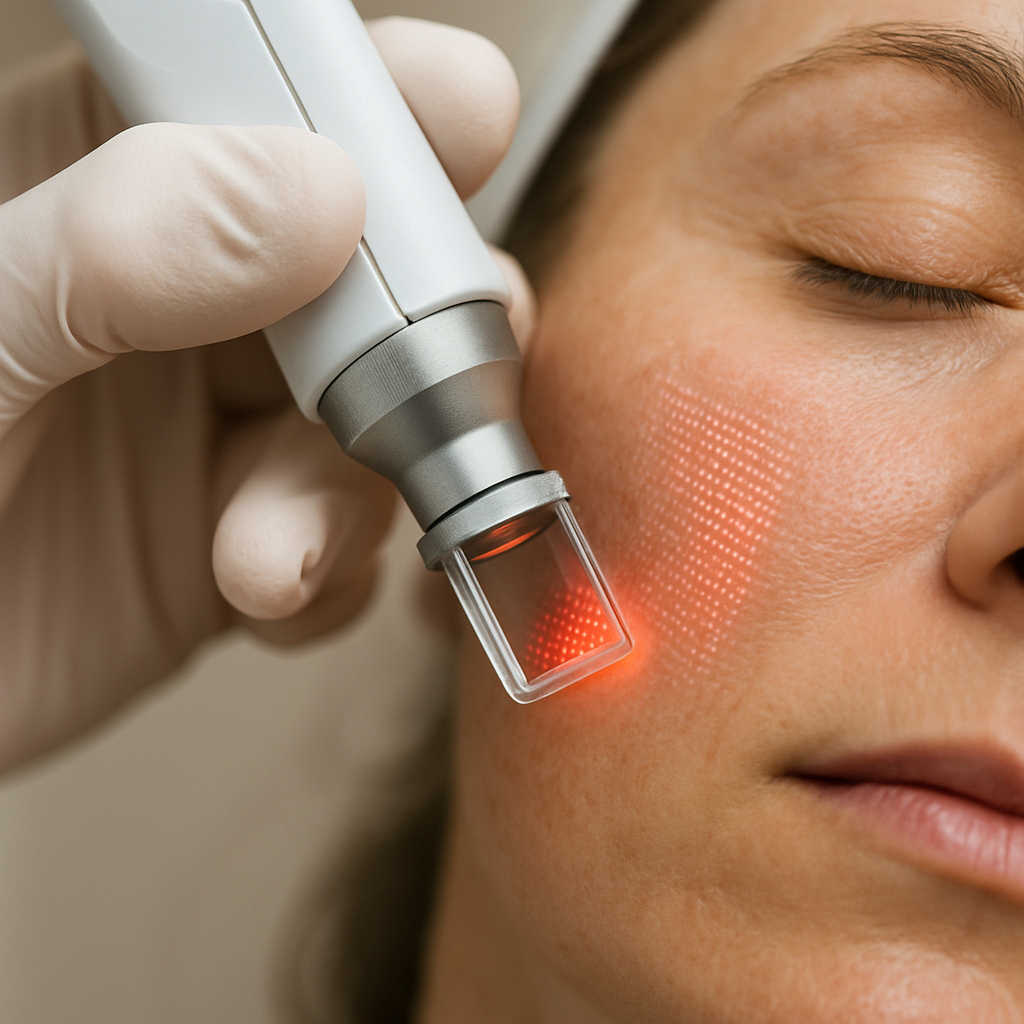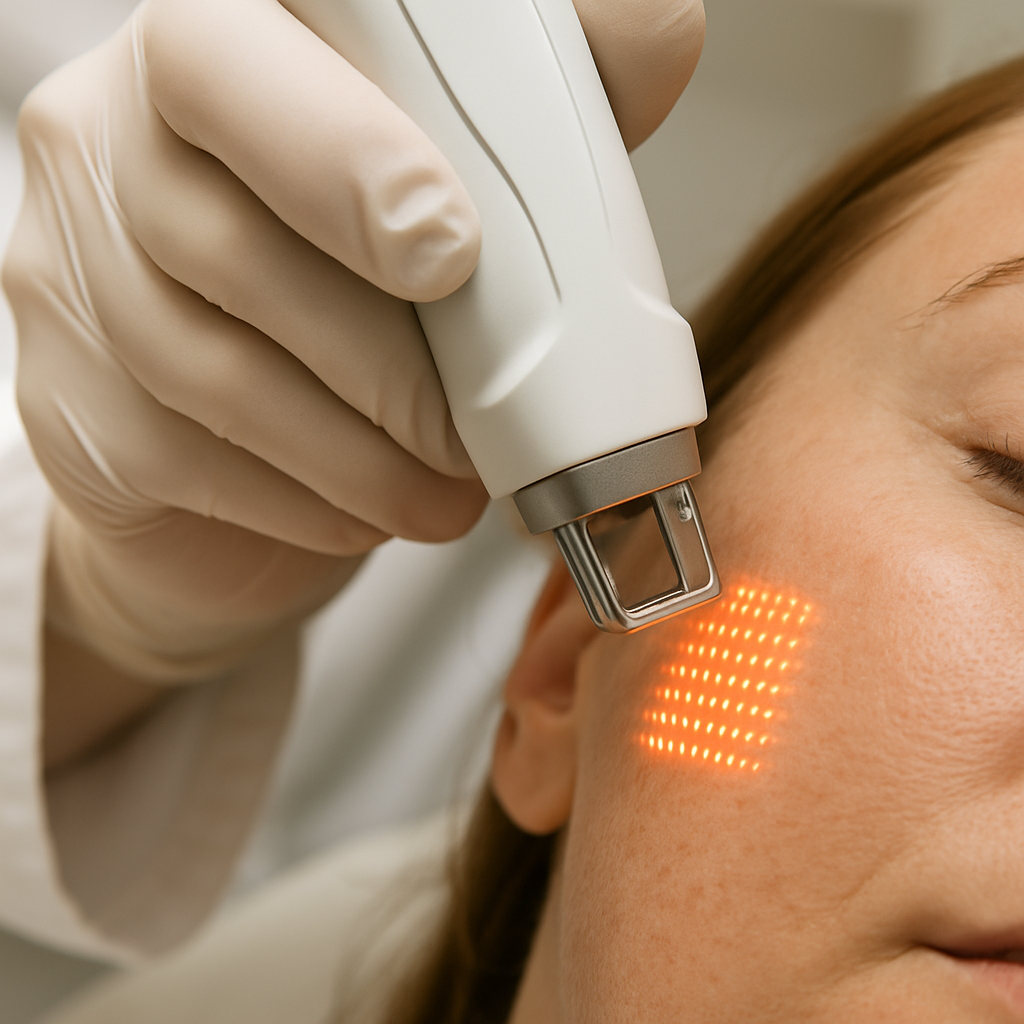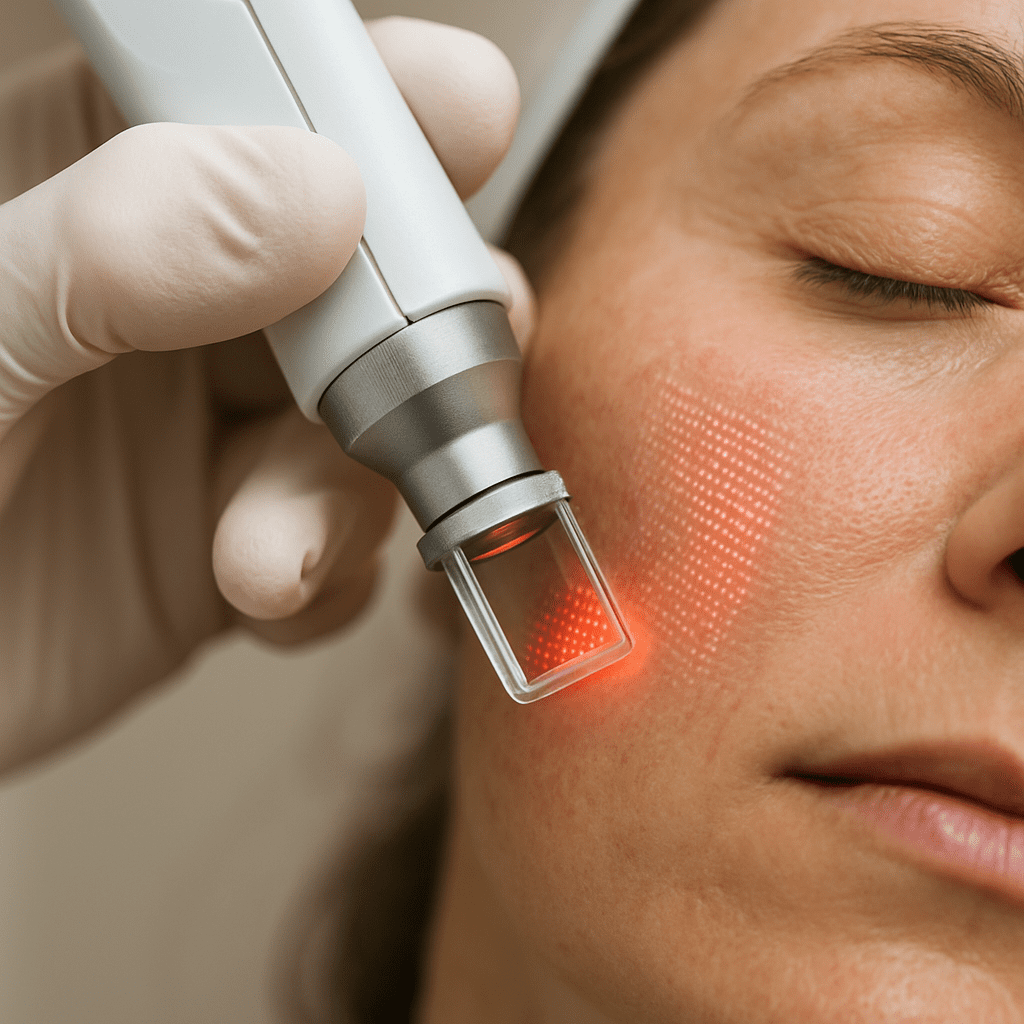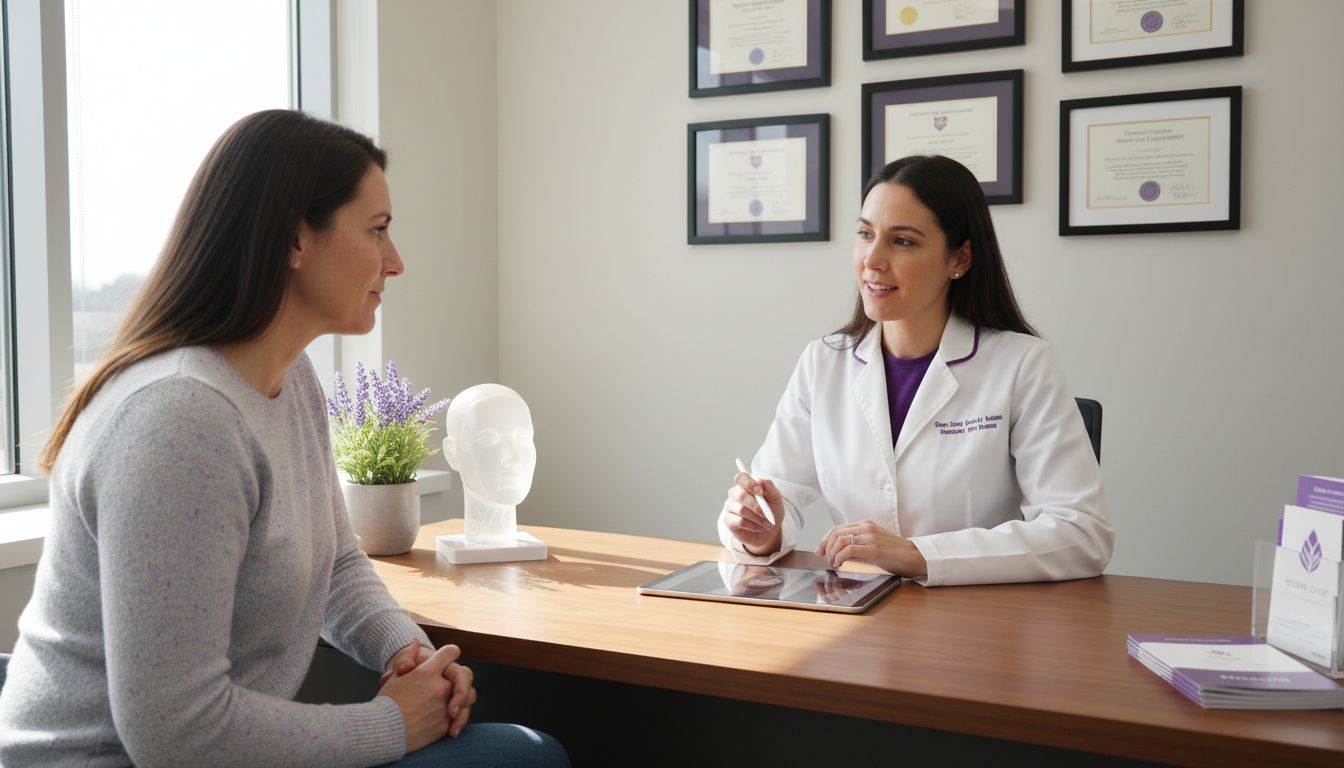Ever looked at a photo and thought, “My skin could use a little magic, but I’m not ready for a full‑on surgery?”
That moment of “maybe there’s a middle ground” is exactly why fractional laser has become the go‑to whisper‑quiet hero in medspas like Simcoe Cosmetic Clinic.
So, what is fractional laser? In simple terms, it’s a skin‑rejuvenation technology that breaks the surface into thousands of microscopic columns, or “fractional” zones, delivering laser energy deep into the dermis while leaving surrounding tissue untouched.
Think of it like a gardener pruning a bush: you trim just enough branches to encourage new growth, and the rest of the plant stays healthy. The laser creates tiny channels that kick‑start collagen production, smoothing wrinkles, fading sunspots, and tightening lax skin.
But here’s the thing—you don’t have to endure the downtime of traditional ablative lasers. Because most of the skin is left intact, healing is quicker, redness fades in a day or two, and you can usually get back to your coffee run or gym session sooner than you’d expect.
Now, imagine you’ve tried countless creams and microneedling sessions with lukewarm results. You’re skeptical, right? That’s totally normal. Fractional laser bridges the gap between topical treatments and more invasive procedures, offering visible improvement without the “paint‑the‑town‑red” recovery period.
And if you’re wondering whether it works for everyone, the answer is pretty flexible. From fine lines on a 30‑year‑old’s forehead to deeper texture issues on a 60‑year‑old’s cheeks, the laser can be customized—different wavelengths, depths, and pass numbers tailor the experience to your skin’s needs.
So, what does a typical session look like? A quick consultation, a numbing cream if needed, and a series of gentle pulses that feel like tiny pinpricks. Most people describe it as a brief, warm sensation—nothing like the “burn” you might picture from older laser tech.
Afterward, you’ll notice a subtle pink glow, a sign that your skin is beginning its repair dance. Within weeks, those micro‑injuries turn into firmer, smoother skin, thanks to the body’s natural collagen cascade.
Ready to explore whether fractional laser fits your skin goals? Let’s dive deeper into how the treatment works, what you can expect during recovery, and how to maximize those glowing results.
TL;DR
Fractional laser creates microscopic columns in your skin, prompting natural collagen renewal that smooths wrinkles, fades spots, and tightens texture with minimal downtime and safe. You’ll see gradual, radiant results in weeks, making it a practical, non‑surgical option for anyone seeking youthful, refreshed skin without a lengthy recovery for you.
What is Fractional Laser Technology?
When you hear “fractional laser,” you might picture a sci‑fi gadget, but the reality is a lot more down‑to‑earth. In essence, fractional laser breaks your skin into thousands of microscopic columns—called micro‑thermal zones (MTZ) for non‑ablative or micro‑epidermal necrotic debris (MEND) for ablative devices. Each column receives a precise burst of light energy while the surrounding tissue stays untouched, so your skin can heal from the edges of those tiny islands of treatment.
Imagine you’re fixing a cracked sidewalk. Instead of ripping up the whole slab, you chip out small sections, fill them with fresh concrete, and let the intact pieces hold everything together. That’s exactly how fractional laser works, and it’s why you see less downtime compared with traditional full‑surface lasers.
How the laser talks to your skin
The laser’s wavelength determines which skin component absorbs the energy. Water and collagen are the main chromophores, so when the light hits them, it heats the tissue to around 55‑56°C. That controlled heat nudges fibroblasts to produce new collagen, while the tiny columns of damage (often just 100‑300 µm wide) act as scaffolding for fresh tissue to grow.
Studies show that after a series of treatments, the epidermis thins less, elastin fibers become more organized, and overall skin tension improves according to clinical observations on laser resurfacing. The result? Smoother texture, more even tone, and a subtle lift that builds over weeks.
Real‑world examples
Take Jenna, a 42‑year‑old marketing manager who struggled with stubborn sunspots on her cheeks. She tried a bunch of serums, but the pigmentation persisted. After three fractional CO₂ sessions spaced four weeks apart, the spots faded dramatically, and her skin felt firmer. She reported only mild pinkness for two days and was back to her yoga class on the third.
Then there’s Mark, 58, who noticed deep laugh lines around his mouth. He opted for a non‑ablative 1550 nm erbium‑glass laser because his work required him to be camera‑ready. Over four sessions, his lines softened enough that he stopped using filler, and his coworkers commented on his “refreshed” look.
Choosing the right type
Not every fractional laser is created equal. Ablative lasers (like CO₂ or Er:YAG) vaporize tiny columns of skin, delivering stronger results in fewer sessions—but they also need a longer healing window (typically 7‑10 days). Non‑ablative lasers heat the tissue without breaking the surface, so recovery is often just a few hours, though you might need 3‑5 treatments for comparable improvement.
When you sit down with a clinician at Simcoe Cosmetic Clinic, they’ll assess your skin’s Glogau grade, discuss your downtime tolerance, and recommend a wavelength and depth that match your goals. Think of it as a custom‑tailored haircut rather than a one‑size‑fits‑all haircut.
Step‑by‑step: What to expect on the day
- Consultation & skin analysis – the provider maps out columns and decides on pass numbers.
- Topical numbing (usually EMLA) applied 30‑40 minutes before the laser.
- Laser session – you’ll feel a series of gentle pinpricks; most people describe it as a warm “tingle”.
- Post‑treatment care – a soothing moisturizer or a thin antibiotic ointment, plus strict SPF 50 for at least four weeks.
- Recovery – redness fades in 1‑2 days (non‑ablative) or 3‑5 days (ablative). Full re‑epithelialization takes about a week for ablative work.
Pro tip: keep a simple diary of how your skin feels each day. You’ll notice subtle swelling the first night, then a gentle flaking that signals collagen remodeling in action.
Common questions you might be asking
Is it safe for darker skin tones? Yes, when a non‑ablative 1550 nm laser is used, the risk of hyper‑pigmentation drops dramatically. Does it treat sagging? Fractional laser tightens by stimulating collagen, but for pronounced laxity you might combine it with a skin‑tightening modality like HIFU.
And what about cost? A single session can range from $300 to $800 depending on the device and treatment area, but most patients see the best ROI after a series of 3‑4 sessions.
Curious how fractional laser stacks up against other energy‑based treatments? What is RF Microneedling: Understanding the Treatment, Benefits, and Results offers a great side‑by‑side comparison of mechanisms and downtime.
Bottom line: fractional laser is a middle‑ground hero that delivers noticeable rejuvenation without the “off‑the‑grid” recovery of traditional ablative resurfacing. By creating controlled micro‑injuries, it awakens your skin’s own repair crew, giving you smoother, brighter skin that feels—and looks—naturally refreshed.

How Fractional Laser Works: The Science Behind It
Ever wonder what actually happens under the skin when you hear “what is fractional laser?” Let’s pull back the curtain and walk through the science in a way that feels like a coffee‑shop chat.
Laser‑Skin Interaction
First off, the laser isn’t a giant saw. It fires ultra‑short pulses of light at a specific wavelength, and the skin’s water and collagen soak up that energy like a sponge. That absorption heats the tissue to about 55‑56 °C – just enough to nudge fibroblasts (the skin’s building crew) into action without scorching the whole surface.
And because the light is delivered in tiny, spaced‑out columns – called micro‑thermal zones (MTZ) for non‑ablative devices or micro‑epidermal necrotic debris (MEND) for ablative ones – the surrounding skin stays untouched, acting like a safety net that speeds up healing.
Thermal Zones & Collagen Cascade
Each column is only 100‑300 µm wide, but inside that narrow tunnel the heat causes collagen fibers to contract and shrink to about one‑third of their original length. That immediate tightening is the first visible perk.
Then the real magic kicks in: the body launches a wound‑healing cascade. Enzymes called matrix metalloproteinases break down the damaged collagen, and over the next weeks new, more organized collagen sprouts in its place. Think of it as a construction crew ripping out old, warped beams and erecting fresh, sturdy ones.
Studies show this neocollagenesis can continue for up to six months, meaning you keep getting smoother, firmer skin long after the last session.
Real‑World Cases
Take Jenna, a 42‑year‑old marketing manager who was fed up with stubborn sunspots. After three fractional CO₂ sessions spaced four weeks apart, the spots faded dramatically and her skin felt tighter. She only dealt with mild pinkness for two days and was back to yoga by day three.
Then there’s Mark, 58, who dreaded his deep laugh lines. He opted for a non‑ablative 1550 nm erbium‑glass laser because his job demands a camera‑ready look. Four sessions later, his lines softened enough that he ditched filler, and coworkers started commenting on his “refreshed” vibe.
Choosing Ablative vs Non‑Ablative
Not every fractional laser is the same. Ablative lasers (like CO₂ or Er:YAG) actually vaporize tiny columns of skin, delivering stronger results in fewer visits but requiring a longer downtime – usually a week of gentle care.
Non‑ablative lasers, on the other hand, heat the tissue without breaking the surface. Recovery is often just a few hours of mild redness, but you may need three to five sessions to match the results of one ablative treatment.
During your consultation, the clinician will assess your skin’s Glogau grade, discuss how much downtime you can handle, and then pick the wavelength and depth that suit your goals – kind of like getting a haircut tailored to your face shape.
Step‑by‑Step: What Happens on Treatment Day
- Consultation & skin analysis – the provider maps out the columns and decides on pass numbers.
- Topical numbing (usually EMLA) applied 30‑40 minutes before the laser.
- Laser session – you’ll feel a series of gentle pinpricks; most people describe it as a warm “tingle”.
- Post‑treatment care – a soothing moisturizer or thin antibiotic ointment, plus strict SPF 50 for at least four weeks.
- Recovery – redness fades in 1‑2 days (non‑ablative) or 3‑5 days (ablative). Full re‑epithelialization takes about a week for ablative work.
Pro tip: keep a simple diary of how your skin feels each day. You’ll notice a subtle swelling the first night, then a gentle flaking that signals collagen remodeling in action.
Pro Tips for Best Results
- Stay hydrated – water helps fibroblasts work efficiently.
- Use a gentle, fragrance‑free moisturizer for the first week to keep the skin moist.
- Never skip sunscreen. UV exposure can undo weeks of collagen building.
- Avoid harsh exfoliants or retinoids for at least two weeks post‑treatment.
- Consider a short course of oral antiviral (like valacyclovir) if you have a history of cold sores – it’s a common precaution.
Bottom line: fractional laser creates controlled micro‑injuries that awaken your skin’s own repair crew. By understanding the science – from light absorption to collagen remodeling – you can set realistic expectations, choose the right device, and maximize those glowing results.
Benefits and Risks of Fractional Laser Treatments
So you’ve seen the glow‑up after a fractional laser session on Instagram and wonder, “Is this really worth it for me?” You’re not alone—most of us have that mix of excitement and a tiny pinch of doubt when something sounds that good.
Let’s break it down together. First, the upside: fractional laser is essentially a controlled “micro‑injury” that wakes up your skin’s own repair crew. The result is a cascade of new collagen, smoother texture, and a more even tone.
What you gain
According to the Cleveland Clinic, laser skin resurfacing can reduce wrinkles, fade scars, even out pigmentation, and tighten skin, all while prompting fresh collagen growth.Cleveland Clinic explains the benefits of laser resurfacing. That’s why people notice softer fine lines after just a few weeks and a gradual brightening that can last months.
Take Laura, a 35‑year‑old teacher who struggled with stubborn melasma on her cheeks. After three non‑ablative fractional sessions spaced a month apart, the brown patches softened dramatically, and her colleagues commented that she “looked rested.” She reported only mild pinkness for 48 hours and was back to grading papers the next day.
Then there’s Tom, 62, who wanted to lessen deep crow’s‑feet before his retirement party. He opted for an ablative CO₂ fractional treatment because he wanted faster results. Within a week, the fine lines appeared shallower, and after the full healing period he felt his skin was noticeably firmer.
Beyond aesthetics, many patients love the minimal downtime compared with traditional full‑surface resurfacing. Because most of the skin stays intact, you can usually resume light activities—like a coffee run or gentle yoga—within a day or two.
Potential downsides
Every beauty tool has a flip side, and fractional lasers are no exception. The most common side effects are temporary redness, swelling, and a mild sunburn‑like sensation. For most folks, these fade within a few days.
More serious, though rarer, risks include infection, prolonged hyper‑pigmentation (especially in darker skin tones), scarring, and, in very aggressive cases, a temporary loss of skin elasticity. The Cleveland Clinic notes that while complications are uncommon, they can happen if the laser settings are too high or aftercare is neglected.Cleveland Clinic discusses laser resurfacing side effects.
Imagine you’re on a beach vacation two weeks after treatment and you skip sunscreen. That sun exposure can undo weeks of collagen remodeling and even trigger a stubborn dark spot. Or picture using a harsh exfoliant too early—it can irritate the fresh micro‑channels and increase infection risk.
How to maximize benefits and keep risks low
1. Pre‑treatment screening. Your clinician should review your medical history for keloid tendency, recent sunburn, or active herpes. If you have a history of cold sores, a short antiviral course can prevent flare‑ups.
2. Patch test. A tiny test spot helps gauge how your skin reacts to the chosen wavelength and fluence.
3. Follow post‑care precisely. Keep the treated area clean with a gentle cleanser, apply a fragrance‑free moisturizer, and use a broad‑spectrum SPF 50+ every morning. Avoid retinoids, glycolic acids, and vigorous rubbing for at least two weeks.
4. Hydration is key. Drinking plenty of water supports fibroblast activity, which speeds collagen synthesis.
5. Watch for warning signs. If redness persists beyond a week, you notice pus, increasing pain, or a sudden change in color, contact your provider right away—early antibiotics can prevent deeper infection.
6. Plan your schedule. For ablative treatments, set aside a week of low‑key activities. For non‑ablative work, a weekend is usually enough.
By treating the laser session like a small surgery—prep, precise execution, and diligent aftercare—you tilt the odds heavily toward glowing results.
Quick comparison
| Aspect | Benefit | Risk | Mitigation |
|---|---|---|---|
| Collagen boost | Improves firmness & fine lines | Potential over‑tightening | Use appropriate depth; follow provider’s protocol |
| Pigment correction | Fades sunspots & melasma | Hyper‑pigmentation in darker skin | Choose non‑ablative 1550 nm; strict sun protection |
| Downtime | Usually 1‑3 days (non‑ablative) or 7‑10 days (ablative) | Infection or prolonged erythema | Cleanse gently, avoid harsh products, monitor healing |
Bottom line: fractional laser can be a game‑changer for texture, tone, and elasticity—if you respect the science and give your skin the TLC it deserves.
Ready to take the next step? Start by booking a consultation where you can discuss your skin goals, ask about the best wavelength for your tone, and get a personalized post‑care checklist.

Types of Fractional Laser: Ablative vs Non-Ablative
Ever felt torn between wanting big‑time results and fearing a week‑long Instagram blackout? That tug‑of‑war is exactly why we compare ablative and non‑ablative fractional lasers side‑by‑side. You’ll see which one fits your schedule, skin tone, and comfort level.
First, let’s picture what “ablative” actually means. Ablative lasers – think CO₂ or Er:YAG – vaporize tiny columns of skin, creating micro‑holes that go all the way through the epidermis. The body then rebuilds those spots with fresh collagen, so the lift can be dramatic after just one session.
Non‑ablative lasers, on the other hand, heat the dermis while leaving the surface intact. The micro‑thermal zones act like a gentle nudge, prompting collagen production without the skin‑peeling drama.
How the two approaches differ in practice
Imagine you’re planting a garden. An ablative treatment is like pulling out whole patches of soil to plant new seedlings – you get fast growth but you have to wait for the earth to settle. Non‑ablative is more like sprinkling fertilizer over existing grass – slower, but you can keep walking on it.
That analogy shows up in real‑world results. A split‑face study found three 1540 nm non‑ablative sessions produced the same clinical improvement as a single 2940 nm ablative session, even though the non‑ablative route required more visits (Borges et al., 2014). The trade‑off? More appointments, but less downtime.
Speaking of downtime, most patients in a large safety review reported only minor, short‑lived redness after non‑ablative work, while ablative CO₂ laser patients needed about a week of low‑key activities (FACES+ study, 2017). That’s why you’ll often hear clinics suggest non‑ablative for busy professionals and ablative for those who can afford a short break.
Real‑world examples
Meet Jenna, a 42‑year‑old marketing manager. She wanted her stubborn sunspots gone before a summer wedding but couldn’t miss work. Her provider chose a non‑ablative 1550 nm erbium‑glass laser. After four spaced sessions, the spots faded, and Jenna was back to conference calls within a day of each visit.
Now think about Mark, 58, who was fed up with deep laugh lines around his mouth. He opted for a single fractional CO₂ session because he wanted visible change before his retirement party. The result? Noticeably tighter skin after the week‑long healing period, and he didn’t need any filler afterward.
Quick decision guide
If you’re still unsure, use this checklist:
- Do you need results fast? Go ablative.
- Can you afford a week of gentle care? Ablative fits.
- Do you have darker skin or a low pain tolerance? Non‑ablative is usually safer.
- Are you treating large surface areas? Non‑ablative often requires fewer side‑effects.
And remember: a good clinic will customize depth, pass number, and wavelength to your skin’s Glogau grade and Fitzpatrick type.
Side‑effect snapshot
Both methods share common mild side‑effects—redness, swelling, and temporary flaking. Ablative lasers, because they remove the epidermis, carry a higher chance of infection or prolonged erythema if after‑care is neglected. Non‑ablative lasers usually cause only brief pinkness, but because you need multiple passes, the cumulative irritation can add up.
Pro tip: keep a simple post‑treatment diary. Note the color of your skin each morning, any tingling, and how long it takes to return to normal. That data helps your provider fine‑tune the next session.
Bottom line comparison
| Feature | Ablative (CO₂, Er:YAG) | Non‑Ablative (1550 nm, 1927 nm) |
|---|---|---|
| Downtime | 7‑10 days of limited activity | 1‑3 days of mild redness |
| Depth & Effect | Full‑thickness column removal, stronger collagen boost | Dermal heating only, gentler collagen stimulation |
| Ideal Candidates | Patients seeking rapid, dramatic change and can pause social events | Those with darker skin tones, busy schedules, or low pain tolerance |
So, which side of the fence are you on? If you crave a quick, noticeable lift and can handle a brief recovery, the ablative route may be your ticket. If you prefer a slower, almost “no‑break” experience, the non‑ablative option lets you keep sipping coffee while your skin rebuilds beneath the surface.
Ready to decide? Book a consultation at Simcoe Cosmetic Clinic, bring your schedule, skin concerns, and let the provider map out the exact wavelength and pass number that matches your goals.
Choosing the Right Fractional Laser Provider: Key Questions
Alright, you’ve read about what is fractional laser and you’re already picturing smoother skin. The next step? Finding a provider who won’t leave you guessing or scrolling through endless “before‑and‑after” reels.
Think of it like picking a dentist for a crown—you want skill, comfort, and a clear plan, not just a shiny office. Below are the questions that turn a vague “maybe” into a confident “yes, I’m ready.”
1. What’s the clinician’s training and certification?
Laser work isn’t a hobby you pick up on a weekend. Look for a board‑certified dermatologist or a surgeon who’s completed a dedicated laser‑resurfacing fellowship. The American Board of Cosmetic Surgery stresses that expertise matters more than the brand of the machine according to their guidance on laser safety. Ask to see proof of credentials and how many fractional laser procedures they’ve performed in the past year.
2. Which laser device will they use, and why?
Not all fractional lasers are created equal. CO₂ and Er:YAG are ablative; 1550 nm and 1927 nm are non‑ablative. The right choice hinges on your skin tone, downtime tolerance, and the depth of concerns you want to tackle.
Ask the provider to explain the wavelength, pulse duration, and how they’ll adjust the depth for your Fitzpatrick type. A good clinician will say something like, “We’ll start with a lower fluence to see how your skin reacts, then fine‑tune on the next visit.” That shows they’re customizing—not just pushing a one‑size‑fits‑all protocol.
3. Can I see a before‑and‑after portfolio of patients similar to me?
Real‑world results beat stock photos every time. Request photos of clients who share your age, skin tone, and concern (think fine lines, sunspots, or acne scarring). Pay attention to the healing timeline they show—do they highlight the immediate post‑treatment redness as well as the 6‑week outcome? That transparency tells you they understand the whole journey.
4. What’s the pre‑treatment screening process?
Safety starts before the laser even fires. A thorough intake should cover recent acne medication, isotretinoin use, cold‑sore history, and any tendency toward keloids. Some clinics ask you to stop retinoids two weeks prior; others will prescribe a short antiviral course if you’re prone to herpes flare‑ups. If a clinic skips these questions, you might be risking unnecessary complications.
5. How will they manage pain and downtime?
Everyone’s pain threshold is different, so ask whether they use topical numbing cream, a cooling device, or even oral sedation for deeper ablative work. Then, get a clear post‑care checklist: “Day 1‑2: gentle cleanser, SPF 50+, no strenuous exercise; Day 3‑7: moisturize, avoid hot tubs.” A provider who gives you a printed or digital after‑care plan shows they’re serious about your results.
Does that sound overwhelming? Here’s a quick cheat sheet you can print out and bring to your consultation:
- Provider’s credentials (board‑certified, laser fellowship)
- Device type and why it fits your skin
- Portfolio of similar patients
- Screening questions they ask you
- Pain control options
- Post‑treatment care steps
Having this list in hand turns a vague chat into a focused interview.
6. What’s the cost structure and financing?
Fractional laser isn’t cheap, but you shouldn’t be left guessing. Ask for a breakdown: “$X per session, includes numbing cream, follow‑up, and post‑care products.” Some clinics bundle a series of three sessions at a reduced rate, which often makes sense because most non‑ablative plans need 3‑5 visits for optimal results.
Don’t forget to ask about payment plans. A clinic that offers flexible financing demonstrates confidence in the long‑term value of the treatment.
7. How will they track my progress?
Good providers treat each session like a data point. They might take standardized photos, note skin texture scores, or even use a simple skin diary you fill out at home. The goal is to see measurable improvement—think “10 % reduction in pigment intensity” rather than vague “you’ll look better.”
One client I spoke with kept a daily log of redness levels; her provider adjusted the laser depth after the second visit, cutting her recovery time in half. That kind of iterative approach is the gold standard.
So, what should you do next? Grab a notebook, schedule a consultation, and run through this question list. If the clinic can answer each one confidently, you’re probably looking at a provider who respects both the science of fractional laser and your personal skin story.
FAQ
What is fractional laser and how does it actually work?
Think of fractional laser as a tiny gardener for your skin. It creates microscopic columns—called micro‑thermal zones—where light energy heats water and collagen just enough to trigger a repair response. The surrounding tissue stays untouched, so it acts like a safety net that speeds healing. In a nutshell, the laser nudges your skin’s own building crew to lay down fresh collagen while you recover in a day or two.
Is fractional laser safe for all skin tones?
Safety really depends on the wavelength and depth you choose. Non‑ablative 1550 nm lasers are gentler on darker skin because they target water rather than pigment, which slashes the risk of post‑inflammatory hyper‑pigmentation. If you have a deeper Fitzpatrick scale, a skilled provider will start with a low fluence test spot and adjust the settings. That careful, step‑by‑step approach keeps the treatment effective without turning your skin a shade darker.
What kind of downtime should I expect after a non‑ablative session?
Most people see a mild pink flush that fades in 24‑48 hours—basically a sun‑kissed look. You can usually get back to light activities, like a coffee run or a gentle yoga class, the same day. The key is to protect that fresh skin with SPF 50+, avoid hot tubs, and skip harsh exfoliants for at least a week. Think of it as a short‑term glow‑up rather than a week‑long vacation.
How many treatments will I need to see real results?
Because each micro‑column only treats a fraction of the skin, most providers recommend a series of 3‑5 sessions spaced four to six weeks apart. By the third visit, many clients notice smoother texture and a fade in sunspots. The collagen cascade keeps working for months after the last session, so you’ll often see continued improvement up to six months down the line.
Can I combine fractional laser with other skin‑care procedures?
Absolutely—just timing matters. Most clinicians suggest waiting at least two weeks after a fractional laser before diving into deeper chemical peels or microneedling, giving your skin time to seal the micro‑injuries. You can keep your routine simple with a gentle, fragrance‑free moisturizer and daily broad‑spectrum sunscreen. If you’re eyeing a more aggressive resurfacing, talk to your provider about a staged plan that layers treatments safely.
How do I know if my provider is qualified?
Look for board‑certified dermatologists or surgeons who have completed a dedicated laser‑resurfacing fellowship. Ask how many fractional laser procedures they perform each month and request before‑and‑after photos of patients with a similar skin tone and concern. A good clinician will also explain the specific device, wavelength, and why it fits your goals—no vague “we use the best laser” buzzwords.
Conclusion
So you’ve walked through what is fractional laser, how it works, and what to expect on the day of treatment. The big picture? Tiny columns of light‑induced injury spark a natural collagen cascade that leaves your skin smoother, brighter, and a little firmer.
Remember Jenna’s sun‑spot story and Mark’s laugh‑line win? Those real‑world snapshots show that the results aren’t just theory— they’re achievable for busy people who can spare a few minutes of downtime.
What should you do next? Grab a notebook, schedule a consultation at Simcoe Cosmetic Clinic, and ask the provider about the device that matches your skin tone and goals. A good clinician will walk you through the number of sessions, pain‑control options, and a post‑care checklist that feels doable.
And don’t forget the aftercare basics: gentle moisturizer, strict SPF, and a quick skin diary to track redness and flaking. Those tiny habits keep the collagen party going for months after your last session.
Bottom line: fractional laser is a middle‑ground hero – more powerful than a simple peel, yet far less disruptive than a full‑surface resurfacing. If you’re ready for a gradual glow‑up without hitting “pause” on your life, it’s worth a deeper chat with a qualified specialist.





